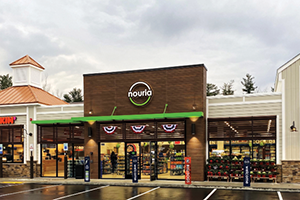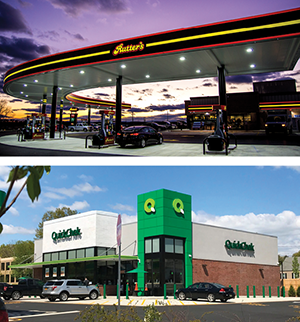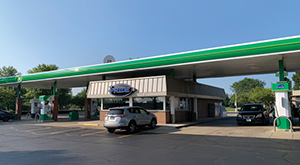Twice a year, The PRIDE Stores Inc. management double checks its door locks. With all 16 locations open 24/7, “it’s one of the security things that can easily be overlooked,” said JT McGlynn, director of operations for the convenience chain owned by Parent Petroleum Inc., based in St. Charles, Illinois. “It’s part of our overall safety procedures that we have in place to ensure customers and employees both are comfortable in our stores and forecourts.”
Your safe should always be bolted to the floor."
Whether your store is open overnight or only during the day, reviewing security measures on a regular basis can keep shoppers and workers safe while serving their needs—all within any retailer’s budget. “When you look at effective crime prevention, it doesn’t have to be expensive,” said Jeff Lenard, NACS vice president of strategic industry initiatives. “But you do have to be proactive in taking preventive steps.”
MINIMIZE THE REWARD
The No. 1 way to prevent crime at your location is to make it not worth the effort. That can be tricky given that convenience stores are one of the few retail places still handling a lot of cash transactions, and “cash is of most value to would-be robbers,” Lenard said. “Having a plan to limit the amount of cash in the drawer is vital.”
 Visibility is a key crime-prevention tool. Use bright interior lighting, and limit signage on windows and doors that would obscure views into and out of the store.
Visibility is a key crime-prevention tool. Use bright interior lighting, and limit signage on windows and doors that would obscure views into and out of the store.
Many retailers solve that potential problem by having a drop safe inaccessible by staff. “By putting deposits in a time-delayed or smart safe, employees no longer have access to funds,” said Donny McKay, vice president of marketing and engineering for American Security. “Many retailers put up stickers on the entrance doors and near checkout notifying everyone that employees don’t have access to safe funds.”
McKay pointed out the higher the dollar value being stored in a safe, the higher the safe’s security should be. “Your safe should always be bolted to the floor,” he said. “Since no safe is 100% impenetrable, it’s also a good idea to have a burglary alarm in place, as well as surveillance cameras positioned so that the safe and anyone accessing it are in plain view.”
For a safe to work for you, retailers must train clerks how to use it. McGlynn noted POS systems now remind cashiers when it’s time for a money drop into the safe, such as having an alert when the till reaches a certain amount. “That has been great to helping our employees keep the money in the safe, thus reducing the available cash amount,” he said.
Some stores have lighting get brighter when someone moves to a particular area of the store, which is quite effective as a deterrent for shoplifting."
Some stores have gone cashless as a way to reduce potential crime. “Our cashless, self-service-only retail transactions have lowered theft at Platte Street Mercantile because there is no cash to take,” said Janine Williams, CEO/founder of Impulsify and co-owner of the Denver store. “There’s also a ‘successful transaction’ sound to our self-service kiosks to give our attendants audio awareness a transaction was completed.”
MINIMIZE THE RISK
One key to crime prevention is to show potential criminals your location isn’t worth the risk. Dr. Read Hayes, research scientist at the University of Florida and director of the Loss Prevention Research Council, recommends starting with the outside. “The parking lot is the first and last place employees and customers encounter, so make sure it’s well-lighted, neat and clean,” he said.
Visibility into the store itself also signals whether or not the location is high risk to would-be criminals. “Having minimal signage on the windows and doors provides good visibility for those entering and exiting the store, something many criminals would shy away from,” Hayes said.
As in the forecourt, interior lighting should be bright throughout the store to both encourage purchases and to discourage any criminal activity. “Some stores have lighting get brighter when someone moves to a particular area of the store, which is quite effective as a deterrent for shoplifting,” Hayes said.
 Forecourt lighting should be bright for nighttime safety, and keeping the area clean and uncluttered is a signal that your store is a safe one.
Forecourt lighting should be bright for nighttime safety, and keeping the area clean and uncluttered is a signal that your store is a safe one.
THEFTS HAPPEN
More and more retailers are simply allowing merchandise theft to happen these days. “It’s all about keeping the customers and employee safe,” Hayes said. “We’ve also seen some retailers, like Walgreens in San Francisco, shutting down locations because of high incidents of theft.”
The PRIDE Stores have a “no confrontation and no chase” policy when it comes to shoplifters. “The safety of our employees comes first, and their well-being is more important than any items in the store,” McGlynn said. “We emphasize that during our extensive onboarding training, and each year review it as part of our overall refreshers. We also regularly discuss any area incidents—whether at our stores or nearby retailers—and go over what the employees did right and what they should have done instead.”
At Platte Street Mercantile, attendants are not encouraged to “accuse or address potential item theft for their own safety,” Williams said. “A Gatorade just isn’t worth it. However, we do provide our staff with hospitality training on nonconfrontational ways to address an unpaid-for item.”
PERSONAL SECURITY
Some retailers also hire their own security guards to bump up store safety. “This can be effective in crime prevention if the guards have visible radios and microphones to call for help—you want to create the impression that the guard will be capable of reporting accurately to the police what happened in the store,” Hayes said. Off-duty law enforcement often make ideal private security guards for retailers.
 The PRIDE Stores have a "no confrontation and no chase" policy when it comes to shoplifters. And the Chicago-area retailer welcomes police officers to stop by for free fountain drinks and coffee.
The PRIDE Stores have a "no confrontation and no chase" policy when it comes to shoplifters. And the Chicago-area retailer welcomes police officers to stop by for free fountain drinks and coffee.
Two PRIDE stores, one in downtown Chicago and the other in Cicero, Illinois, have private security guards 24 hours. “We hired off-duty Chicago police officers for those locations a few years ago because of altercations in the parking lot and other nearby incidents that created an unsafe atmosphere for our employees and customers,” McGlynn said.
The retailer also encourages on-duty law enforcement and firefighter personnel to stop by for free fountain drinks and coffee anytime. “You want them to hang out at your locations as that makes your employees and customers feel safer,” he said.
As Lenard said, “Allowing police and other law enforcement space to fill out paperwork or use the restrooms during a shift can provide an additional layer of security at your stores.”
Allowing police and other law enforcement space to fill out paperwork or use the restrooms during a shift can provide an additional layer of security at your stores."
STAFF IT RIGHT
For low traffic times, it can be tempting to reduce the staff to a single cashier, but these retailers and experts say that can invite trouble. “While most of our locations are busy around the clock, there are some that aren’t,” McGlynn said. “We still staff all stores with a minimum of two employees at all times.”
The Platte Street Mercantile attendants roam the store, assisting customers and overseeing self-service transactions to ensure items have been logged correctly. “This means the attendant isn’t distracted by a single transaction and has more awareness of what’s going on in the store,” Williams said. By following these simply steps, convenience retailers can create a safe and secure location for both employees and customers. “Our No. 1 job is to make people feel safe in our stores,” Lenard said. “Achieving that can be as simple as installing a time-release drop safe and improving lighting and visibility into the store—those are steps any retailer can implement and see immediate results.”
Smile! You're on Camera
Artificial intelligence has dramatically increased the use of cameras at retail, whether for cashierless checkout or recording customer movement throughout the store. “AI is playing a larger role in crime deterrence at self-checkout than previously possible,” said Dr. Read Hayes, research scientist at the University of Florida and director of the Loss Prevention Research Council.
Within the past five years, The PRIDE Stores upgraded its surveillance system to motion-activated cameras and switched to digital instead of analog. “This allows us to zoom in on certain things, like license plates or in-store displays,” said JT McGlynn, director of operations for the chain owned by Parent Petroleum Inc. “One of the newer features is a 360 camera that blends eight to 12 cameras together to get an orbital view of the store, which we use to watch customer travel patterns.”